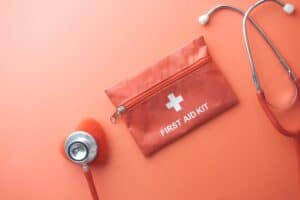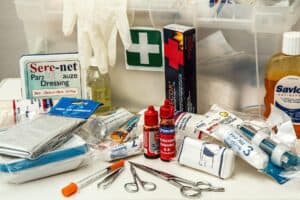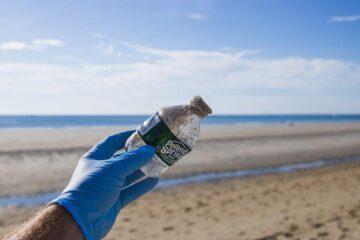First Aid Kits Treatments
Almost everyone will require first aid at some point in their lives. In an emergency or accident, you want to be prepared. You may already have a good understanding of first aid. But knowing that first aid is the immediate and first help offered to someone who is ill or injured is essential to preserving life and promoting recovery. First aid care may be sufficient for minor injuries like cuts, bruises, or burns.
However, you should offer first aid assistance for severe health conditions until advanced care becomes available. Understanding the basics of first aid can mean the difference between life and death to the victim.
A first aid kit is a bag, pack, or box that contains supplies that you can use to treat minor injuries such as bruises, sprains, cuts, and scrapes. More comprehensive kits can also hold convenience items, life-saving emergency supplies, or survival supplies. But why do you need a first aid box or kit? Read on to know why first aid kits are essential for any car, home, travel, and workplace.
What is the importance of a first aid kit?

Accidents occur all the time. They happen everywhere and to everybody. Even when things seem like nothing can go south, some bad luck and mishap can lead to an emergency. So, you must be prepared for such emergencies.
Keeping a well-stocked first aid kit in your home or office or carrying it when heading for outdoor activities can assist you in responding promptly to common emergencies and injuries.
Here are the top reasons why you need to keep a first aid kit in your car, office, and home:
- Stops loss of blood instantly: You can use the bandage and gauze in your first aid kit to stop excessive bleeding immediately.
- Treat injuries quickly: A well-stocked first aid kit can help you handle health emergencies such as cuts, burns, or injuries as quickly as possible, thus reducing the damage.
- Reduces risk of complications: A first aid box, in most cases, can help prevent further complications with the medical condition or injury.
- Relieves pain instantly: If a scald or burn occurs, you should apply first aid to the affected part as fast as possible. The purpose is to relieve pain and avoid further damage.
- Keep antibiotics within your reach: In case of a bruise or cuts, you need to use antibiotics in the first aid kit as quickly as possible to prevent further damage.
- Gives you peace of mind: Ultimately, having a well-equipped first aid kit can help you and your loved ones get some peace of mind, knowing they are safe when an emergency strikes.
- Reduces recovery time: Not offering first aid to an ill or injured person can cause death, but even if they survive, they may have to deal with a longer recovery period.
What are the 4 Ps of first aid?
First aid entails a wide range of emergency actions. It could be as basic as offering reassurance while waiting for the emergency service providers to arrive. Or it could be conducting CPR to save a life. It involves all actions performed while waiting for the availability of professional health practitioners.
The objectives of first aid can easily be remembered by the four P’s: Promote quick recovery, Preserve life, Provide pain relief and Prevent an already worsening situation. In first aid, ABC is a synonym for airway, breathing, and circulation.
What is the use of gauze pads in your first aid kit?
Gauze pads are crucial items to include in your first aid kit. In case of a severe injury that cannot be treated with a bandage, a gauze pad may be helpful. To stop excessive bleeding, applying a gauze pad together with medical tape can be more effective than a conventional bandage. Gauze pads can also be utilized to clean wounds or apply ointments. Because gauze bandages come in different sizes, make sure that you try to incorporate different sizes in your first aid kit.
What is the use of tweezers in a first aid kit?
Tweezers are valuable tools to include in your first aid kit. You should include tweezers in your first aid kit no matter the application, as they can be an important tool for eliminating debris like splinters, dirt, or glass from the wounds. This should be performed with utmost care to avoid further injury.
There are various types of tweezers, each with its specific size, purpose, and shape. Some examples include a flat tip, needle tip, curved tip, blunt tip, and angled tip.
What is the purpose of a medical taper in a first aid kit?
Medical tape (otherwise known as the adhesive or surgical tape is applied to attach gauze pads, bandages, and other bandages to help them stick around wounds. They are a kind of pressure-sensitive tape, i.e., a tape that sticks and remains firm under pressure. There is no need to activate it with heat or using a solvent. Adhesive tapes can be built from various materials, but most of them are breathable for ease of use and comfort.
What triangular bandages are used in a first aid box or kit?
A triangular bandage is applied as a pad or arm sling to stop bleeding. It can also be used to immobilize or support an injury to a joint or bone or as a pad over an injury. Here are some of the common injuries where triangular bandages can be helpful, including:
- Head injury
- Sprained ankle
- Eye injuries
- Hip wrap
- Shoulder injuries
- Minor hand burns
What is the use of cotton wool in a first aid kit?
Cotton wool has some properties that make it perfect for wound care and dressing. It has a higher absorption rate and is gentle on your skin. In addition, it is ideal for cleaning wounds as well as offering protection and padding.
What is the function of hydrogen peroxide in a first aid kit?
Hydrogen peroxide is a mild antiseptic applied on the skin to prevent infection of minor scrapes, cuts, and burns. It is important equipment in your first aid kit that can help you when your loved one has been injured before they seek advanced medical care.
First Aid Kit Items and Their Uses
First Aid kit item Uses
1. A pair of safety pins- Helps to secure a bandage or remove a splinter.
2. Latex gloves- Safeguards the first aider from getting infections.
3. Thermometer- Helps to measure your body’s temperature.
4. Adhesive bandages- They are used together with gauze pads to cover wounds.
5. A pair of scissors Used to cut clothing or bandages
6. Antibiotic ointment- Helps to safeguard against bacteria and prevent infection from cuts, burns, and abrasions.
7. Instant cold pack- Offers cold therapy to muscular injuries and sprains.
8. Ibuprofen or Aspirin Reduces fever, pain, and swelling
9. Antiseptic wipes- Helps to minimize the risk of infection and Expedite recovery process.
10. First aid manual- It offers basic instructions on how to treat wounds, bites, sprains, and other minor injuries.
11. Breathing barrier- A breathing barrier is essential if CPR is to be conducted.
12. Pain Killers- They help to ease discomfort and pain after muscle sprain or back pain.
13. Antihistamines- Helps to stop any allergic reaction.
14. Emergency blanket- Reduces body heat loss.
15. Calamine lotion- Stop itching and operates as a drying agent for oak, skin rashes, and sumac.
How Do You Use a First Aid kit in case of an Emergency?
By offering immediate care during an accident or emergency, you can assist an injured or ill person before health practitioners arrive. And by so doing, you may be able to save a life. Using the first aid kit items listed above, you can be able to offer the following immediate care services:
Bleeding Control
Regulating bleeding in a major wound needs a large supply of bandages and dressings and even the application of a tourniquet. A first aid kit should include numerous triangular bandages which can be utilized for splinting or tourniquets, stacks of gauze pads for direct wound dressing, and roller gauze for securing dressings.
Wound Care
The care of wound injuries is crucial when you cannot access medical care urgently. If the injury continues to bleed, the focus should be on stopping of bleeding, and no wound care is first needed. For injuries with controlled bleeding, you should assess the wound for infection after every six hours. The occurrence of infection will call for further medical care and evaluation, as such infections can result in life-threatening infections.
Here are examples of common injuries and the first aid kit items you need to use:
- Scrapes and cuts: Adhesive bandages, gauze pads, antiseptics, and non-latex gloves are utilized to control bleeding.
- Strains and Sprains- A sprained finger or twisted ankle will need an instant cold pack to help minimize pain and swelling.
- Broken bone- Triangular bandages, elastic bandages, first aid tape, and splinting material can help you treat a broken bone.
- Deep wound –abdominal dressing, blood-stopping bandages, or compressed gauze are all utilized for deep wounds where pressure should be used to regulate bleeding and get rid of contamination from the wound.
- Gunshot wound- latex-free gloves, pressure bandages, and compressed gauze are used to control excessive bleeding.
Basic knowledge and skills in first aid items are required to use a first aid kit. Some of the crucial things you need to know include:
- Using non-adherent dressings to cover burns and wounds
- Application of crepe bandages to offer support for strains and sprains
- Use emergency blankets to help manage your body’s temperature.
It is one thing to read through the first aid handbook. But getting formal training will take your knowledge of using a first aid kit to another new level. If you don’t know how to use different first aid items properly, consider enrolling in a First Aid course.
Wrapping up
A well-equipped first aid kit is a crucial tool that contains medical supplies that will assist you in responding to everyday accidents and injuries. Buying or creating a first aid kit can keep you and your family prepared to deal with common injuries and emergencies that may happen anytime, anywhere.



